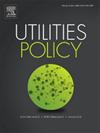Auctioning electricity transmission margins for competitive access to Brazil's National Interconnected System
IF 4.4
3区 经济学
Q3 ENERGY & FUELS
引用次数: 0
Abstract
Recent transformations in the Brazilian Electricity Sector (BES) have generated intense competition for access to transmission capacity in the National Interconnected System (NIS). This situation has highlighted the inherent scarcity of transmission resources and the inadequacy of the current queue criterion for allocating remaining margins. We address the country's new reality by proposing a straightforward and transparent competitive mechanism to enhance allocative efficiency and improve access dynamics. More specifically, we propose a Transmission Margin Auction (TMA) for the BES, based on an open ascending format, according to which all the available capacity established by the National System Operator's (ONS) expansion plan is offered sequentially, and participants are allowed to compete for any available connection point.
拍卖电力传输利润,以竞争进入巴西国家互联系统
巴西电力部门(BES)最近的转型引发了对国家互联系统(NIS)输电能力的激烈竞争。这种情况突出了传输资源固有的稀缺性和当前分配剩余余量的队列标准的不足。我们提出了一种直接透明的竞争机制,以提高分配效率和改善准入动态,从而应对该国的新现实。更具体地说,我们建议对BES进行传输保证金拍卖(TMA),基于开放升序格式,根据该格式,国家系统运营商(ONS)扩展计划建立的所有可用容量依次提供,并且允许参与者竞争任何可用连接点。
本文章由计算机程序翻译,如有差异,请以英文原文为准。
求助全文
约1分钟内获得全文
求助全文
来源期刊

Utilities Policy
ENERGY & FUELS-ENVIRONMENTAL SCIENCES
CiteScore
6.80
自引率
10.00%
发文量
94
审稿时长
66 days
期刊介绍:
Utilities Policy is deliberately international, interdisciplinary, and intersectoral. Articles address utility trends and issues in both developed and developing economies. Authors and reviewers come from various disciplines, including economics, political science, sociology, law, finance, accounting, management, and engineering. Areas of focus include the utility and network industries providing essential electricity, natural gas, water and wastewater, solid waste, communications, broadband, postal, and public transportation services.
Utilities Policy invites submissions that apply various quantitative and qualitative methods. Contributions are welcome from both established and emerging scholars as well as accomplished practitioners. Interdisciplinary, comparative, and applied works are encouraged. Submissions to the journal should have a clear focus on governance, performance, and/or analysis of public utilities with an aim toward informing the policymaking process and providing recommendations as appropriate. Relevant topics and issues include but are not limited to industry structures and ownership, market design and dynamics, economic development, resource planning, system modeling, accounting and finance, infrastructure investment, supply and demand efficiency, strategic management and productivity, network operations and integration, supply chains, adaptation and flexibility, service-quality standards, benchmarking and metrics, benefit-cost analysis, behavior and incentives, pricing and demand response, economic and environmental regulation, regulatory performance and impact, restructuring and deregulation, and policy institutions.
 求助内容:
求助内容: 应助结果提醒方式:
应助结果提醒方式:


